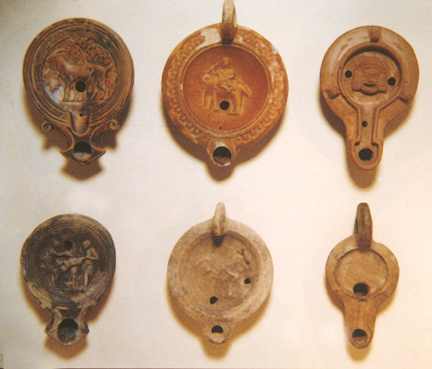
Roman Oil Lamps
100-200 CE, Upper Row: Roman from the Italian peninsula
Lower Row: From the Roman Provinces
ART 198 - HISTORY OF WORLD CERAMICS
| Pottery oil lamps served as a cheap and efficient means of supplying illumination throughout the Roman period. Fueled by vegetable oils and easily broken, they survive in large numbers. Almost always made in press molds, they usually are decorated with scenes showing deities, myths, animals, or flower patterns. Roman forms were extensively copied in the provinces. This was a defining characteristic of the Roman Empire: that wherever Rome conquered, Roman law, language, roads, currency, religion, commerce, and even ceramics were imposed on the local population, in the desire to remake the world in the image of Rome. The Pax Romana, or the period of relative peace imposed by the conquering Romans, was the result of this philosophy. The Roman empire was not so much known for innovation, but of assimilation. The empire was basically a community of coastal cities between which Roman ships brought cargoes of grain, oil, and wine. | Roman Oil Lamps 100-200 CE, Upper Row: Roman from the Italian peninsula Lower Row: From the Roman Provinces |
|
|